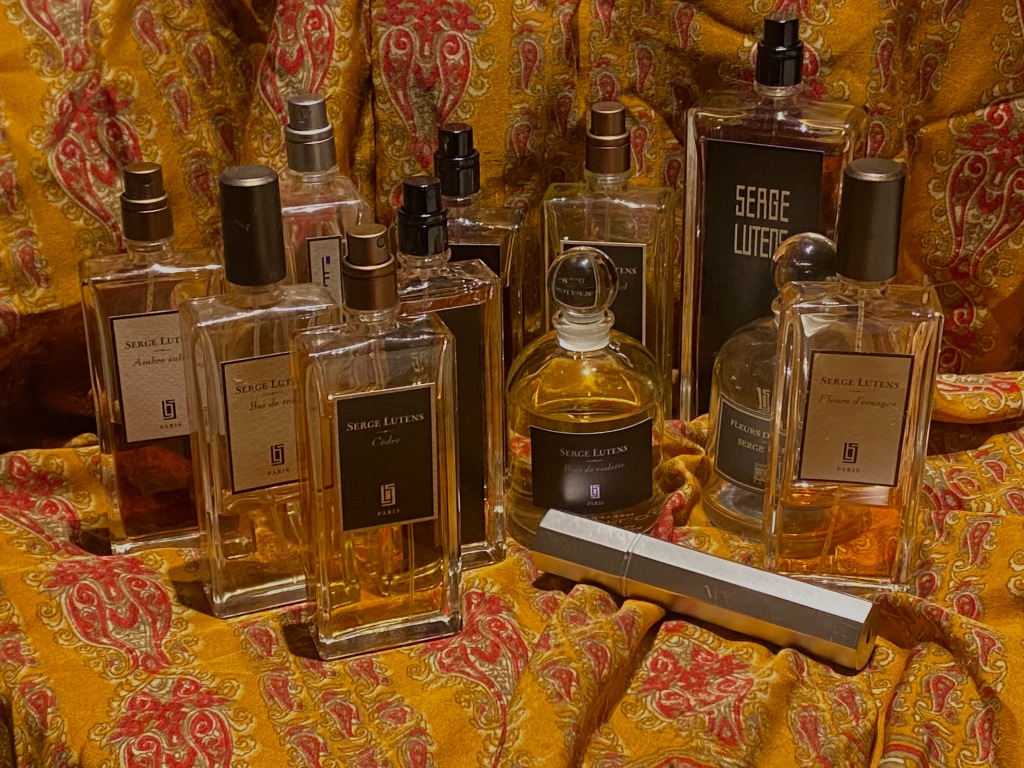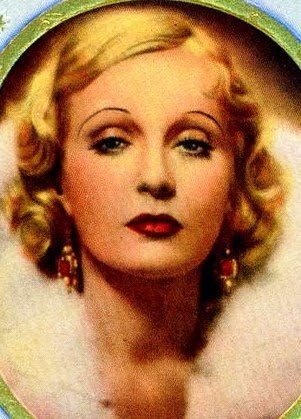
– an armchair guide to Parfums Serge Lutens
It should come as no surprise to most readers of this blog that I am a Major Sergeoholic. Of all the perfume houses I know and adore, I own more Serge Lutens than any other perfume house by a mile – twenty-two at last count, and I can easily rattle off a long wish list on the ones I don’t have – yet.
There’s a reason for this.
Bottled emotions
Eighteen years ago, I lived in a sad state of affairs for a perfume lover. I owned precisely none at all. How or even why I came to land on Makeupalley during that sad state of affairs, I can’t tell you, so imagine my surprise when I discovered actual perfume reviews. Perfume reviews! Makeup I could understand – but perfume? Reviews? Whattheeverloving?
You have to remember – this was a time before blogs, before Basenotes and Fragrantica, Facebook, Instagram … before everything.
And then – a moment that really made me wonder. It was a review of a brand I had never, ever heard of, and claimed that the creative director bottled emotion. Moments in time, sure. Seduction, definitely. All-round fragrant badassery, I could understand that, too. But how in the name of damask rose did you bottle emotion? To say I was intrigued is to understate the issue.
I was positively floored.
Some time later, I came across NYC retailer Aedes de Venustas, who sold the Serge Lutens export line at the time, and their 2003 Christmas catalog was pored over for years until it fell apart as I dreamt of bottled emotions. I couldn’t afford so much as a fragrant tree ornament, but I could at least dream of the day when I did.
Epiphany En Masse
By 2009, my curiosity was killing me not at all softly. Perfume blogs had arrived, and I read them religiously. I can still recall sweating anxious bullets in front of my laptop in those days, trying to resurrect my oxidized schoolgirl French from the dead to request a booklet of wax samples by email from this hyper-chic perfume house, until I finally caved and requested one in English.
Lo and behold, it arrived two days later. With a note, even. As I opened those little booklets with shaking hands, eyed askance by the rest of the household who thought I was nuts, the world tilted on its axis, the stars shifted above, and everything changed. The first one I tried was Chêne. ‘Oak’ is the mundane translation, but oak was the least of it. This was an oak experience, a magic carpet ride into the very soul of a tree, and such a one.
All these many years later, it seems strange that I began with Chêne. Why not the Grand Revolution – Feminité du Bois? I can’t tell you, any more than I can tell you why I have yet to review another forever love, except to say that all the decants I’ve ever received of FdB have been drained to the very last droplets prontissimo before I could plant myself at the keyboard.
Since then, I have, as I’ve said, more bottles and decants of Serge Lutens than any other perfume house on Earth. I certainly don’t like or even love them all, but there’s something for everyone.
Liquid literature
These perfumes have since permeated my consciousness to such an extent, that when the time came to prepare my first novel for publication, I contacted the Palais Royal again. My protagonist was a definite perfumista, and without the writer even noticing, slyly inserted Lutens perfumes into the storyline. Since it had gone from a story with three readers – bless them all – on an unknown blog to the verge of publication as a novel, I needed to get the legalities straight. I asked for permission to “quote” – which is to say, describe perfumes – from M. Lutens’ olfactory output. “What a strange request!”, they wrote me back. Not an hour later, my request was granted.
I had a complete out of body experience. Of all the moments that have defined my perfume life, I think that was one of two I’m proudest of, second only to the perfume project the book itself inspired.
As of late 2021, I’m in the early stages of another novel, and this protagonist, too, loves Serge Lutens perfumes with a flaming heart. Which leads me to …
Free advertising
Since childhood, I’ve believed in sharing my enthusiasms/shouting my loves to the world. One winter day in 2011, I spent an afternoon with a woman who went on to become both a mentor, a massive inspiration and a very dear friend. I explained my burgeoning perfume writing, and had brought samples of many different things, Serge Lutens perfumes included. She lamented that perfume for her had become boring, sameish, insipid. So I introduced her to Boxeuses. It received the all-important husband seal of approval. She bought it posthaste.
From that day forward, she has worn only Serge Lutens. When – being a restless Gemini – she moves on to other Lutens/Sheldrake creations, she passes them on to the impecunious perfume writer who introduced her, bless her forever. These days, she’s a wildly successful painter of wildly exuberant paintings, and somewhere in those explosions of color, motive, life and wit, there’s a distinct, subversive whiff of perfume.
I’m never paid to write reviews. If I dig deep for superlatives in my reviews, you can bet your Nombre Noir (should you be lucky enough to own it, because that, too, is a Lutens creation) it’s because I’m sharing my enthusiasm with all the verve of an over-excited five-year-old. Love is love. Your mileage may vary, but I love what I love. Read all about it.
Hazards before coffee
One bleary-eyed morning not so long ago, an email ticked in. It was an invitation to a virtual masterclass in all things Serge Lutens – the man himself and his astonishing career, the inspirations, and a short introduction to some groundbreaking perfumes from what is now known as Collection Noir – what used to be known as ‘the export line’. I hadn’t even had my coffee yet, but I signed up, posthaste.
The making of a master
The masterclass itself was held this past Thursday, and it was an illumination. One hundred diehard Sergeoholics from all over the world were treated to an absolutely edifying journey; his humble, heartstopping beginnings in Lille, how he began his career, the origins of his unique – and uniquely personal – aesthetic, and on and on. His makeup collection landed in the Guggenheim museum. Diana Vreeland was a fan.
But also how, in 1967, at the ripe old age of twenty-five and in need of a vacation, he came by divine accident to Morocco and became suddenly and acutely aware of the olfactory dimension to life. Having been to Morocco, I can relate – Morocco is an all-out assault to the senses in all the best – and a few of the worst! – ways.
The perfumes in the master class were, in order, Feminité du bois, originally created for Shiseido, Fleurs d’Oranger, Nuit de Cellophane, La Fille de Berlin, Ambre Sultan and Chergui, all part of the Collection Noir.
A few inspirations
Did you know, for instance, that all of his perfumes were conceptualized as unisex from the beginning? In 1992, this was audacious in the extreme. That Feminité du bois set the trend for woody perfumes for women – for decades to come? It was conceived as “the masculine side of femininity and vice versa, inspired by the many wood shops in Marrakesh” (and that breathtaking Atlas cedar.) Or that the Palais Royal boutique, surely THE most drop-dead chic/intimidating/breathtaking of all drop-dead perfume stores, was originally created expressly to sell Feminité du bois? (I’ve never been there, but I do have a personal invitation.)
Fleurs d’Oranger, my first ever Lutens obsession, was inspired by passing a courtyard in the medina of Marrakesh as women were beating an orange tree with sticks to collect the blossoms. All the women were overjoyed to be doing precisely that, and that was the emotion he sought to capture – and did. I bought my last bottle of Fleurs d’Oranger just so I could spray it on my pillows whenever I feel low. Now, it’s the bottle that’s low.
La Fille de Berlin is every rose – and every woman.
Ambre Sultan, his tribute to all things Arabic and Marrakesh, and not incidentally my personal gateway amber, a perfume category I used to loathe, is, in his own words, “not an Oriental, but an Arab – and a Lutens. Don’t expect to fit in.” This explains in a nutshell why I love it so much – it’s not at all a “usual” amber. Inspired by an amber wax stored for years in a thuja wood box, I call this one La Grande Khadine. If you really want to see Salome drop all seven veils, wear La Grande Khadine on a hot summer’s day. If you really want to experience what an amber perfume can do, wear La Grande Khadine. Full stop.
Nuit de Cellophane, which I have yet to try, was inspired by his beginnings in Paris in the early 1960s, by haute couture dresses delivered wrapped in cellophane and is the scent of anticipation. Chergui, named for an easterly desert wind that is less wind and more vacuum, he described as “a desert in flames”, but such flames!
The masterclass was the first of its kind, but it may not be the last. It was a thoroughly bewitching Zoom session, and many of us had all sorts of questions and comments on all things Lutens. What I can tell you is this – no Lutens perfumes will ever be discontinued. Should it come to pass that you are a Lutens neophyte, any – or all! – of these five perfumes would be an excellent introduction.
Perfume, after all, is the most uniquely personal of all art forms. Why wear it? For that matter, why wear perfumes by Serge Lutens? As the man himself asked the question:
“What facet of ourselves will make us shine?”
This facet of myself, this writing which comes from the <3. And last but never least, these perfumes.
With thanks to Emily Veness Budin.
Photo: Yours truly. All bottles from my personal collection.





